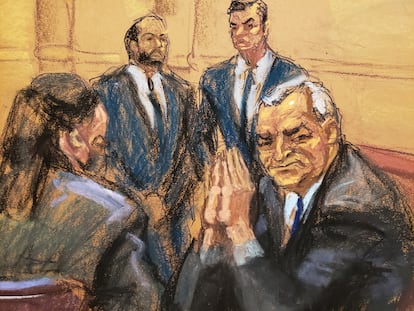García Luna trial in New York becomes a confessional box for cartel chiefs
The judicial process against the former head of Mexican public security has seen several high-ranking narcos reveal the horrors and excesses of the war on drugs

The lights in the Eastern District Court of New York were dimmed at the request of prosecutors. Harold “EL Conejo” Poveda was surrounded by dozens of people: the judge, the jury, lawyers and reporters. But at that moment he was entirely alone. “Can you explain to us what we are watching, please?” he was asked when the images were projected. “Yes of course. It’s my house,” replied the cartel capo. He went on to describe the “fantasy mansion” – the name ascribed to the property by investigative journalists, who also recorded the video being watched in the Brooklyn courtroom – a small palace to the south of Mexico City that took four or five years to build at a cost of almost $7 million. The camera panned to a hand-carved door he bought from India, imitation medieval armor, suspension bridges spanning vast gardens and a swimming pool attached to his personal nightclub. What no one expected was such a detailed account from El Conejo about his animals: he had lions, other big cats, a chimpanzee, exotic birds and a “spectacular” Persian cat that was white, “like cocaine.” Suddenly, Poveda began to cry. His voice cracked as he recalled the kingdom he had constructed in the middle of an all-out cartel war 15 years ago, and the betrayals that eventually led him to lose everything. Earlier in his testimony, he had spoken with pride about evading capture that night. He managed to scale a cage holding white tigers and fled.
Poveda, a former high-ranking member of the Sinaloa Cartel, was called to testify in the trial of Genaro García Luna, Mexico’s Secretary of Public Security during the Felipe Calderón administration (2006-2012), a period when the former president launched a war on drugs, the consequences of which are still being felt today. García Luna faces charges relating to drug trafficking and organized crime, having been arrested in Dallas in December 2019. The testimony of El Conejo and other capos who have become cooperating witnesses is extravagant and sometimes hard to believe. This is not a television show. These are the real actors, who two decades after sowing terror across Mexico are now revealing all.
The most important trial for Mexico since the fall of Joaquín “El Chapo” Guzmán – who was tried and sentenced in the same court and by the same judge handling the García Luna case – has become the backdrop for the biggest collective memory exercise on the war against drugs, which has left hundreds dead. El Conejo talked about how he had his wife’s lover, a Colombian policeman, killed. He detailed how his bosses thought of doing the same to García Luna and “sending his head to the government so that everyone would see that they were not to be trifled with.” He confessed that he had earned between $300 and $400 million during his criminal career. And he added he had pleaded guilty in the United States to trafficking more than a million kilos of cocaine. His record suggested he would spend the rest of his life behind bars, but since 2019 he has been on parole. Some of the witnesses called by the prosecution have already served their sentences, while others are still in US prisons. Of these, some will testify, in the most eagerly awaited appearances of the trial.
“You said you are responsible for the deaths of at least 100 people, is that correct?” one of the defense lawyers, Florian Miedel, asked Óscar “El Lobo” Nava Valencia. The capo was silent for a few seconds. “I have had to make bad decisions in my life, yes,” he replied. “You call this making bad decisions?” Miedel retorted. Confronted with his legacy of violence, Nava Valencia said that if he was there, it was to tell the truth – no matter how raw it was and no matter how uncomfortable it made him. “It’s not easy to sit here and tell it like it is,” the former cartel hitman admitted.
“Did you torture people?” Assistant US Attorney Erin Reid asked Israel Ávila, another former Sinaloa Cartel member. “Several times,” he responded. “More than 10?” Reid said. “Probably,” replied Ávila after a long pause. A middle-ranking member of the organization, said he had also been a victim of cartel brutality. “They tortured me because they thought I was working with the US government,” he said. The loyalty test left him with cut marks on his face, burns all over his body and broken bones. Still, he remained loyal. “I had to keep working for them because if not, they were going to kill me.” Before the prosecutor managed to ask another question, Ávila added: “Not only me, but my family as well.”
Cartel witness claims torture by police
El Conejo also claimed he had been tortured, not by his employers or rival cartels, but by police answering to García Luna. “They blindfolded me,” he told the court. He was beaten before being presented to the authorities and pressured by agents who ransacked two of his properties and forced him into a false confession, he claimed. “They put a plastic bag over me to choke me,” he testified. “They stripped me naked, they gave me electric shocks, until I couldn’t take it anymore.” A day after the kidnapping, he was presented to the media as a kind of war trophy.
In the trial testimony, the line dividing the authorities from organized crime has, at times, been very narrow. García Luna has been accused of ties to drug trafficking stretching over more than 20 years. Sergio “El Grande” Villarreal Barragán, the first witness called by the prosecution, revealed how he disguised himself as a police officer and practically coordinated the 2008 capture of Jesús “El Rey” Zambada, his former partner in the Sinaloa Cartel. The drug traffickers were so embedded in the security forces that they had access to law enforcement uniforms, patrol cars and IDs, according to his testimony. He said they received classified information, that seized drugs were shared out equally, that they appointed and removed police commanders in exchange for multimillion-dollar bribes. “The cartel grew with the help of the government,” said El Grande, the highest-ranking cartel chief to have testified so far. Villarreal Barragán was arrested in 2010 and extradited in 2012, during Calderón’s six-year term. He was released over a year ago after serving his sentence.
El Lobo also revealed he had paid $3 million to secure a 15-minute meeting with García Luna at a car wash in Guadalajara, a front for one of his associates. Ávila said Federal Police agents themselves helped unload drug shipments that landed at Mexico City’s International Airport and other terminals across the country. He said they even helped the traffickers to hide and laughed out loud when they heard on the radio that other police officers were coming after them. Poveda boasted that he was able to enter Colombia without going through immigration, and that police escorted him to the door of the airplane. “It was beautiful,” El Conejo said.
García Luna, according to his lawyers, has said that the testimony delivered borders on the fantastical. “There is no evidence of money or photos or emails or text messages,” said César de Castro, the lead defense attorney. “All of this is based on the testimonies of murderers, kidnappers and traffickers.” Some media and sections of the public have also found the testimony hard to believe: a member of the federal cabinet meeting with several organized crime bosses, receiving suitcases stuffed with over a million dollars in dirty money, and subject to their orders.
Years after the events being laid out and as if remembering past lives, the cartel kingpins enter and leave the confessional at every hearing. At times, they are defiant, at others they seem cornered or remorseful. They talk of unimaginable volumes of money; submarines and boats packed with “merchandise”; luxury cars and expensive jewelry; ridiculous nicknames, and corruption at all levels of government. The prosecution’s challenge is to tie up the loose ends and prove these stories beyond a “reasonable doubt.”
Sign up for our weekly newsletter to get more English-language news coverage from EL PAÍS USA Edition
Tu suscripción se está usando en otro dispositivo
¿Quieres añadir otro usuario a tu suscripción?
Si continúas leyendo en este dispositivo, no se podrá leer en el otro.
FlechaTu suscripción se está usando en otro dispositivo y solo puedes acceder a EL PAÍS desde un dispositivo a la vez.
Si quieres compartir tu cuenta, cambia tu suscripción a la modalidad Premium, así podrás añadir otro usuario. Cada uno accederá con su propia cuenta de email, lo que os permitirá personalizar vuestra experiencia en EL PAÍS.
¿Tienes una suscripción de empresa? Accede aquí para contratar más cuentas.
En el caso de no saber quién está usando tu cuenta, te recomendamos cambiar tu contraseña aquí.
Si decides continuar compartiendo tu cuenta, este mensaje se mostrará en tu dispositivo y en el de la otra persona que está usando tu cuenta de forma indefinida, afectando a tu experiencia de lectura. Puedes consultar aquí los términos y condiciones de la suscripción digital.
More information
Archived In
Últimas noticias
There is as much life left to discover on planet Earth as that which is already known
Dozens presumed dead, around 100 injured in fire at Swiss Alps bar during New Year’s celebration
Is porn for women different from conventional porn? We spoke to those who make it
Cartagena de Indias is sinking: What can the city do to mitigate it?
Most viewed
- Sinaloa Cartel war is taking its toll on Los Chapitos
- Reinhard Genzel, Nobel laureate in physics: ‘One-minute videos will never give you the truth’
- David King, chemist: ‘There are scientists studying how to cool the planet; nobody should stop these experiments from happening’
- Oona Chaplin: ‘I told James Cameron that I was living in a treehouse and starting a permaculture project with a friend’
- The Interoceanic Train, the Mexican alternative to the Panama Canal











































